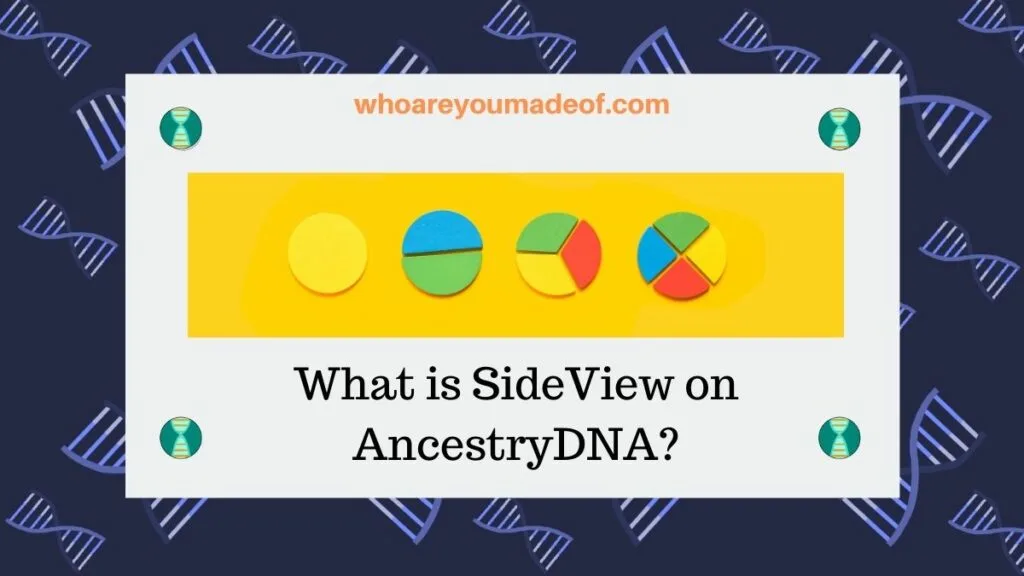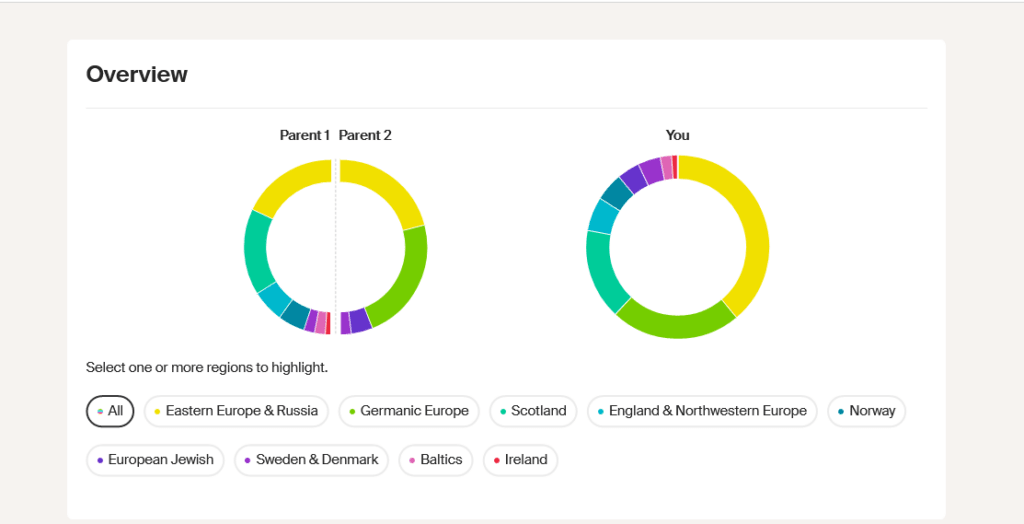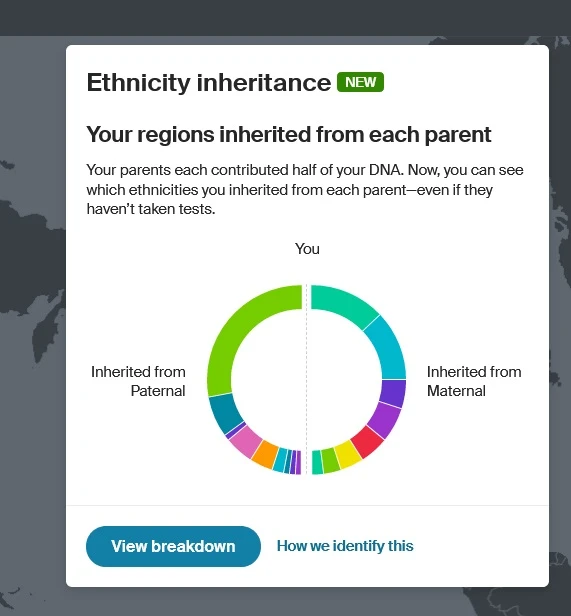SideVew is an exciting new feature of AncestryDNA results that uses technology and data available only to those who have tested their DNA with Ancestry. In this post, learn what you can discover with your SideView results.
I am really very excited about SideView because it helps answer questions that so many DNA testers have when they view their ethnicity estimate. If your parents can't take a DNA test, how can you figure out which ethnicity regions came from each parent?

For those of us who love using our AncestryDNA results to build our family trees and learn more about our ancestors, it is very helpful to be able to work out which regions might correspond to a particular line of our tree. This information can provide valuable clues as to where our ancestors may have lived.
So, of course I was thrilled when I found out that Ancestry was working on a tool to solve this exact question for the millions of people who have tested their DNA on the site. Are you ready to learn about SideView?
Let's get started!
What is SideView on your Ancestry results?
SideView on Ancestry is a feature that helps provide more insights to its customers by helping to understand DNA inheritance of ancestry regions by parent. In other words, it can help you learn which regions on your Ancestry ethnicity estimate came from your mother, and which came from your father.
The best part about this new feature? It can give you information about paternal and maternal DNA inheritance even if your mother and father have not taken an AncestryDNA test.
For example, the results below are from my mother's test. Both of her parents passed away before these types of DNA tests were available, and so we never really had a way to be sure which ethnicity regions she inherited from each parent.

If you scroll down a bit on the results page, you will see a specific breakdown per region where it lists exactly the percentage estimated to have been inherited from each parent. In addition, you can now see the ethnicity regions that you inherited from each parent at the chromosome detail using the Ancestry Chromosome Painter.
This is a very exciting change for Ancestry customers. For a variety of reasons, many people are unable to ask their parents to take a DNA test, which has left people on their own when it comes to trying to figure out which side of the family passed down DNA matching the regions on their results.
With the new SideView feature, everyone will be able to see the estimate of which DNA came from their paternal side and maternal side, regardless of whether their parents took DNA tests. This feature is also very exciting for those DNA testers who are fortunate enough to have had a parent take a test.
By viewing your parent's results, you will be able to see their SideView results. This means that you will be able to have an estimate for which DNA came from two or four grandparents, which is also very valuable.
And the even better than best part? According to Ancestry's press release, they are working on fine-tuning this technology to use it for identifying which DNA matches are on the paternal vs. maternal side of your family. As of today, we depend on using the Shared Matches tool to figure this out.
Do your parents need to take a DNA test for SideView to work?
No, your parents do not need to take a DNA test with Ancestry in order for you to have SideView on your results.
The reason that the SideView technology is so exciting is because it solves a very difficult to solve problem. Since we inherit the same amount of DNA from both parents, it is difficult to "phase", or sort, into which half was inherited from the mother and father.
If you have had at least one parent test their DNA with Ancestry, then you might already be familiar with the concept of "phasing". When you filter out DNA matches that only match your mother or father, then you are phasing your DNA matches, or sorting them, by paternal or maternal sides.
This is, essentially, what the SideView feature does, except we get to see which regions likely came from which parents, and of course, we can see the information regardless of whether our parent actually took an AncestryDNA test.
Prior to this update, those individuals who could not have their parents test directly typically had to guess at which ethnicity regions came from which side of the family. Those of you who have been researching your genome for a while know that guessing doesn't really have its place when it comes to DNA.
How do they determine which ethnicity you got from each parent for SideView?
As mentioned above, Ancestry is able to phase your DNA matches into groups. For the vast majority of AncestryDNA customers, these groups of phased matches will cover your entire genome.
Ancestry is able to sort our tens of thousands of DNA matches (i.e people who are related to us) into groups of people who are likely related to each other, and also to us. This allows their algorithm to do the difficult computations required to estimate which ethnicity regions came from which side of the family, all based on our DNA matches.
If you have heard of the Leeds Method for DNA match analysis, which is used to determine the common ancestor for a group of matches, or have used DNA Painter, then you might be able to recognize the idea behind this feature.
Of course, the Ancestry algorithm has access to processing power far beyond our individual capabilities, which helps the SideView results provide more insight than most of us could hope to achieve on our own.
How can you access your SideView results?
To access your SideView results, all you have to do is log in to your Ancestry account and access your DNA Story or DNA Insights page. This feature was released on April 13, 2022 and should be available to all AncestryDNA customers soon.
From your main DNA Story page, where your Ethnicity Estimate overview is visible, you will see a new section below the Ethnicity Estimate heading that says "Ethnicity Inheritance". Click the blue "View Breakdown" link to see your SideView Ethnicity Inheritance results:

Click the blue button to see your results!
One of the best parts about choosing Ancestry DNA for your autosomal DNA test is that new features are added to your account automatically as they are developed and released. This means that you get new DNA matches, periodically updated ethnicity estimates, and of course, cool features like SideView, without having to take a new test.
How accurate are SideView results on Ancestry?
For about 90% of Ancestry DNA customers, the SideView results will be about 95% accurate. Considering the sheer number of people who have tested their DNA with Ancestry, this is a pretty impressive accuracy.
In fact, it is actually because of the large number of people who have chosen Ancestry to test their DNA that enables a tool like SideView to work as well as it does. Ancestry has more than 20 million DNA testers in their DNA network, or database, as we sometimes call it, to potentially be matched to you as genetic relatives.
These matches are sorted and grouped to help work out which regions you likely inherited from your paternal and maternal ancestors.
If you check your SideView and feel that they are not as accurate as they could be, don't fret. As more people from your individual extended family test their DNA, your SideView results should improve in accuracy.
At this point, we do not know for sure how often the results will update, but we do know that there will be future updates to the feature. Ancestry has shown that it is always working to improve and update our results, so I feel confident that this feature will only get better, too.
Does the SideView feature mean that we don't need our parents to take a DNA test?
If you have the option of having your parents, aunts, uncles, or grandparents, take an AncestryDNA test, this is still going to be my recommendation. There is even more to learn from viewing their results directly, such as:
- Your relative's complete ethnicity estimate
- Their SideView results (to help isolate which grandparent may have passed down certain regions to you)
- Your relative's list of DNA matches, which can help you phase your DNA matches or identify which side of your tree your matches are related through
The SideView feature and advanced technology adds to what we can learn by having additional relatives take DNA tests. Plus, having more family members involved in DNA testing makes it more exciting, too.
Conclusion
I hope that this article has helped you understand more about the SideView feature, how it works, and just how amazing this is going to be for helping us learn more about our ancestors. Definitely log in to check out your updated results to see what they reveal for you.
If you get the chance to check out your SideView results and they reveal something interesting, or if you have any questions, be sure to leave a comment below.
Thanks for stopping by today!

Toni
Sunday 17th of April 2022
According to side view, my sister and I do not share parents from the same place. Easier than side view is shared matches and good old tree building.
Mercedes
Tuesday 19th of April 2022
I agree that family tree building is the best way to figure out ancestry, for sure!
Joseph Clark
Sunday 17th of April 2022
Thanks ! The side view feature is coool !! I would guess that parent 1 is father and parent 2 is mother ? My parents are quite similar 😂
Mercedes
Tuesday 19th of April 2022
Hi Joseph, It does make it extra tough to figure out who is who when the parents have similar ancestry!
Donald Propp
Sunday 17th of April 2022
The new tool shows ancestry estimates for "Parent 1" and "Parent 2" but which one is my mother and which one is my father? Or is Ancestry.com unable to determine that?
Mercedes
Tuesday 19th of April 2022
Hi Donald, As of right now, the SideView results do not specify which is Parent 1 and which is Parent 2. It could really be either one, but there are a few ways you could decipher which is which. I wrote a post about how I figured this out for my mother's results, which you might find useful: https://whoareyoumadeof.com/blog/ancestry-sideview-understand-your-results/